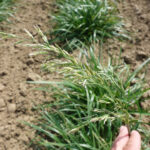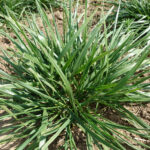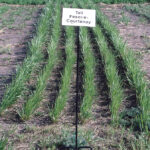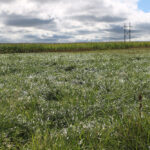Tall Fescue
Lolium arundinaceum
General Description
Tall fescue is a deep-rooted, perennial bunchgrass. Although it is considered a cool season grass and is adapted to cool and humid climates, tall fescue can tolerate more heat than other cool season grasses. It has an extensive coarse, dense root system and short rhizomes. Longevity is extremely variable and dependent on variety. It is similar to meadow fescue but is distinguished by having wider, less glossy leaves.
Tall fescue has stems that grow to a height of over 100 cm (39 in). They are smooth, semi-erect, and fairly thick. Leaves (12 mm wide) are mostly basal, with blades that are flat, dark green and hairless. The leaves are shiny & waxy and resist drought somewhat; also making tall fescue a bit more challenging to cure for hay. Seed heads develop with 3 to 10 flowers per spikelet. Tall fescue is cross-pollinated and the seed shatters easily.
Endophytes are a fungus that can live within tall fescue plants improving the plant. However, endophytes can produce a toxin (ergovaline) harmful to livestock and wildlife. The toxin restricts blood flow, which often shows as lameness and then sloughing of feet (‘fescue foot’) or the loss of extremities such as the tip of the tail and/or eat. Further, endophytes can lead to reproductive issues, including abortions. The turf-type varieties most often carry the fungus in the seed/plants, which then pass it on to the seed it produces. Forage-type varieties with low-endophyte levels are best utilized for livestock production. Feed should be tested when in doubt.
Type
Tame grass.
Origin
Central Europe, North Africa. Hardier varieties developed in North America.
Longevity
At least 5 years. Persistence is dependent on variety.
Use
Pasture, hay, sailage, stockpiled. Forage varieties with noted winter hardiness should be used. Turf-type varieties are grown for seed production but are not suitable for high forage yield and quality.
Optimal Time of Use
Spring, summer, fall, winter. Hay tall fescue by early heading. Regrowth may be grazed or stockpiled. Tall fescue can be continually or rotationally grazed. Leave at least 10 cm (4 in) for substantial regrowth to occur. Basal leaf growth develops from new tillers throughout the season. Begins growing a little later than other grass- manage accordingly. Good for summer grazing or stockpiling for fall and early winter grazing as it maintains quality well after fall frosts and stands erect through light snowfall.
Recovery After Use
Requires a minimum 30-45 days of recovery after use. This time is highly variable depending on the moisture conditions. Tolerates frequent, close grazing by producing more basal leaf growth. Sod is resistant to animal hoof traffic. Rest from grazing over the last 4 to 6 weeks of the growing season improves winter hardiness.
Tolerates frequent, close grazing by producing more basal leaf growth. Sod is resistant to animal hoof traffic. Rest from grazing over the last 4 to 6 weeks of the growing season improves winter hardiness.
Palatability/Nutritional Value
Good palatability in vegetative stages. Tall fescue has an average total digestible nutrient (TDN) level of 59% and crude protein of 9-12% mid-summer. Endophytes in turf varieties can be a problem for livestock. Purchase endophyte-free seed and test forages from non-endophyte free stands.
Annual Precipitation min/max (mm)
400mm /600mm
Drought Tolerance
Moderate tolerance. Recovers quickly.
Flooding Tolerance
Withstands 2-5 weeks of spring flooding and tolerates wet or waterlogged soil often spring through fall.
Winter Hardiness
Fair to good tolerance depending on the variety. Select varieties noted for hardiness. Winter is highly dependent on variety, snow cover conditions, drought, and breaks in dormancy.
Soil Texture Preference
Prefers deep, moist, silty to clayey soils. Sub-irrigated sites may also be suitable.
Erosion Control
Moderate erosion control.
Salinity Tolerance
Moderate tolerance. Good tolerance to salinity makes it a good choice for irrigated saline pasture land.
Acidity Tolerance
High tolerance. Tolerates soil pHs as low as 4.7 but yields better on slightly acidic to neutral soils.
Alkalinity Tolerance
High tolerance.
Seeds per kg
454,000 seeds/kg (206,000 seeds/lb)
Suggested Mixtures
Grows well with tall growing legumes such as alfalfa, birdsfoot trefoil, red clover, and alsike clover for hay. Consider seeding with meadow brome and a legume for pasture or stockpiled grazing- shorter growing legumes such as cicer milkvetch or sainfoin are a good fit. On lower areas it pairs well with timothy, creeping red fescue and alsike clover. In saline areas it has been used in mixes with smooth bromegrass, slender wheatgrass, and green wheatgrass.
Grows well with tall growing legumes such as alfalfa, birdsfoot trefoil, red clover, and alsike clover for hay. Consider seeding with meadow brome and a legume for pasture or stockpiled grazing- shorter growing legumes. On lower areas it pairs well with timothy, creeping red fescue and alsike clover.
Ease of Establishment
Strong seedling vigour helps tall fescue establish relatively easily, especially if competition and soil fertility are managed.
Competitiveness
Once established, tall fescue is competitive. Potentially invasive depending on location and variety. In some habitats in the northern US tall fescue, especially those varieties with endophytes, are considered invasive and persistent.
Management Considerations
Select a forage variety which has been tested as endophyte free. Test turf varieties for endophytes if using for feeding or grazing and manage accordingly (See Alberta Forage Manual). Tall fescue will produce new tillers from basal growth throughout the summer with good production. Responds favorably to fertilizers.
Select a forage variety which has been tested as endophyte free. Test turf varieties for endophytes if using for feeding or grazing and manage accordingly. Tall fescue will produce new tillers from basal growth throughout the summer with good production. Responds favorably to fertilizers.
British Columbia Rangeland Seeding Manual, Saskatchewan Dryland Forage Species Adaptation Tool, USDA Plants Database, Manitoba Forage Adaptation and Comparison Guide, Alberta Forage Manual
Tall fescue is adapted to the Sub-Boreal Spruce, Sub-Boreal Pine-Spruce and Interior Cedar-Hemlock zones. In the southern part of the Central Interior region, it is adapted to wetter parts of the Interior Douglas-fir zone and to irrigated and subirrigated areas in the Bunchgrass zone and the drier parts of the Interior Douglas-fir zone.
Tall fescue is adapted to the wetter parts of the Interior Douglas-fir zone, the Interior Cedar-Hemlock zone, and to irrigated and subirrigated areas in the Bunchgrass, Ponderosa Pine zones and drier parts of the Interior Douglas-fir zone.
Tall fescue is adapted to the Peace-Liard region, but survival is dependent on variety and snow cover.



